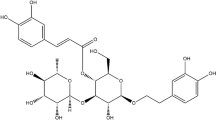Abstract
Protective effects of extracts of the new cultivar MNU-32 developed from blackberry (Rubus fruticosus) cultivar V-9 against H2O2-induced oxidative stress in HepG2 cells were investigated. DPPH radical scavenging activities of MNU-32 and V-9 extracts were 570.00 μg/mL (IC50) and 644.55 μg/mL (IC50), respectively. Inhibition effects of MNU-32 extracts against intracellular ROS generation, cell cytotoxicity, and lactate dehydrogenase release were higher than for the V-9 extract in H2O2-treated HepG2 cells. Compared with the V-9 extract, MNU-32 extract treatments produced higher levels of lipid peroxidation attenuation and greater protection against DNA damage, restored the activity of superoxide dismutase in H2O2-treated HepG2 cells, and increased protein expression levels of superoxide dismutase in HepG2 cells in a dose and time-dependent manner. MNU-32 blackberry extracts exerted protective effects against H2O2-induced cell damage due to higher anthocyanin contents than the V-9 blackberry extract.
Similar content being viewed by others
References
Ghaffari H, Ghassam BJ, Prakash HS. Hepatoprotective and cytoprotective properties of Hyptis suaveolens against oxidative stress-induced damage by CCl4 and H2O2. Asian Pac. J. Trop. Med. 5: 868–874 (2012)
Aqil F, Gupta A, Munagala R, Jeyabalan J, Kausar H, Sharma RJ, Singh IP, Gupta RC. Antioxidant and antiproliferative activities of anthocyanin/ellagitannin-enriched extracts from Syzygium cumini L. (Jamun, the Indian Blackberry). Nutr. Cancer 64: 428–438 (2012)
Kwok HH, Ng WY, Yang MSM, Mak NK, Wong RNS, Yue PYK. The ginsenoside protopanaxatriol protects endothelial cells from hydrogen peroxide-induced cell injury and cell death by modulating intracellular redox status. Free Radical Bio. Med. 48: 437–445 (2010)
Kaume L, Howard LR, Devareddy L. The blackberry fruit: A review on its composition and chemistry, metabolism and bioavailability, and health benefits. J. Agr. Food Chem. 60: 5716–5727 (2012)
Cuevas-Rodriguez EO, Yousef GG, Garcia-Saucedo PA, Lopez-Medina J, Paredes-Lopez O, Lila MA. Characterization of anthocyanins and proanthocyanidins in wild and domesticated Mexican blackberries (Rubus spp.). J. Agr. Food Chem. 58: 7458–7464 (2010)
Koca I, Karadeniz B. Antioxidant properties of blackberry and blueberry fruits grown in the Black Sea Region of Turkey. Sci. Hortic. 121: 447–450 (2009)
Kaume L, Gilbert WC, Brownmiller C, Howard LR, Devareddy L. Cyanidin 3-O-β-d-glucoside-rich blackberries modulate hepatic gene expression, and anti-obesity effects in ovariectomized rats. J. Funct. Foods 4: 480–488 (2012)
Elisia I, Hu C, Popovich DG, Kitts DD. Antioxidant assessment of an anthocyanin-enriched blackberry extract. Food Chem. 101: 1052–1058 (2007)
Cho BO, Ryu HW, Jin CH, Choi DS, Kang SY, Kim DS, Byun MW, Jeong IY. Blackberry extract attenuates oxidative stress through up-regulation of Nrf2-dependent antioxidant enzymes in carbon tetrachloride-treated rats. J. Agr. Food Chem. 59: 11442–11448 (2011)
Lee JH, Kang NS, Shin SO, Shin SH, Lim SG, Suh DY, Baek IY, Park KY, Ha TJ. Characterisation of anthocyanins in the black soybean (Glycine max L.) by HPLC-DAD-ESI/MS analysis. Food Chem. 112: 226–231 (2009)
Lee BW, Lee JH, Gal SW, Moon YH, Park KH. Selective ABTS radical-scavenging activity of prenylated flavonoids from Cudrania tricuspidata. Biosci. Biotech. Bioch. 70: 427–432 (2006)
Cho BO, Ryu HW, So Y, Jin CH, Baek JY, Park KH, Byun EH, Jeong IY. Hepatoprotective effect of 2,3-dehydrosilybin on carbon tetrachloride-induced liver injury in rats. Food Chem. 138: 107–115 (2013)
Sharma V, Singh P, Pandey AK, Dhawan A. Induction of oxidative stress, DNA damage and apoptosis in mouse liver after sub-acute oral exposure to zinc oxide nanoparticles. Mutat. Res. 745: 84–91 (2012)
Heo SJ, Ko SC, Kang SM, Kang HS, Kim JP, Kim SH, Lee KW, Cho MG, Jeon YJ. Cytoprotective effect of fucoxanthin isolated from brown algae Sargassum siliquastrum against H2O2-induced cell damage. Eur. Food Res. Technol. 228: 145–151 (2008)
Murapa P, Dai J, Chung M, Mumper RJ, D’Orazio J. Anthocyanin-rich fractions of blackberry extracts reduce UV-induced free radicals and oxidative damage in keratinocytes. Phytother. Res. 26: 106–112 (2012)
Im SE, Nam TG, Lee H, Han MW, Heo HJ, Koo SI, Lee CY, Kim DO. Anthocyanins in the ripe fruits of Rubus coreanus Miquel and their protective effect on neuronal PC-12 cells. Food Chem. 139: 604–610 (2013)
Hwang YP, Choi JH, Choi JM, Chung YC, Jeong HG. Protective mechanisms of anthocyanins from purple sweet potato against tert-butyl hydroperoxide-induced hepatotoxicity. Food Chem. Toxicol. 49: 2081–2089 (2011)
Li G, Kang J, Yao X, Xin Y, Wang Q, Ye Y, Luo L, Yin Z. The component of green tea, L-theanine protects human hepatic L02 cells from hydrogen peroxide-induced apoptosis. Eur. Food Res. Technol. 233: 427–435 (2011)
Nik E. Lipid peroxidation: Physiological levels and dual biological effects. Free Radical Bio. Med. 47: 469–484 (2009)
Kang KA, Lee KH, Zhang R, Piao MJ, Kang MY, Kwak YS, Yoo BS, You HJ, Hyun JW. Protective effects of Castanopsis cuspidate through activation of ERK and NF-κB on oxidative cell death induced by hydrogen peroxide. J. Toxicol. Env. Heal. A 70: 1319–1328 (2007)
Zhang R, Chae S, Kang KA, Piao MJ, Ko DO, Wang ZH, Park DB, Park JW, You HJ, Hyun JW. Protective effect of butin against hydrogen peroxide-induced apoptosis by scavenging reactive oxygen species and activating antioxidant enzymes. Mol. Cell. Biochem. 318: 33–42 (2008)
Giudice A, Montella M. Activation of the Nrf2-ARE signaling pathway: A promising strategy in cancer prevention. BioEssays 28: 169–181 (2006)
Vari R, D’Archivio M, Filesi C, Carotenuto S, Scazzocchio B, Santangelo C, Giovannini C, Masella R. Protocatechuic acid induces antioxidant/detoxifying enzyme expression through JNK-mediated Nrf2 activation in murine macrophages. J. Nutr. Biochem. 22: 409–417 (2011)
Xing HY, Liu Y, Chen JH, Sun FJ, Shi HQ, Xia PY. Hyperoside attenuates hydrogen peroxide-induced L02 cell damage via MAPK-dependent Keap1-Nrf2-ARE signaling pathway. Biochem. Bioph. Res. Co. 410: 759–765 (2011)
Cho ES, Lee KW, Lee HJ. Cocoa procyanidins protect PC12 cells from hydrogen-peroxide-induced apoptosis by inhibiting activation of p38 MAPK and JNK. Mutat. Res. 640: 123–130 (2008)
Author information
Authors and Affiliations
Corresponding author
Rights and permissions
About this article
Cite this article
Cho, BO., Ryu, HW., Lee, CW. et al. Protective effects of new blackberry cultivar MNU-32 extracts against H2O2-induced oxidative stress in HepG2 cells. Food Sci Biotechnol 24, 643–650 (2015). https://doi.org/10.1007/s10068-015-0084-1
Received:
Revised:
Accepted:
Published:
Issue Date:
DOI: https://doi.org/10.1007/s10068-015-0084-1




